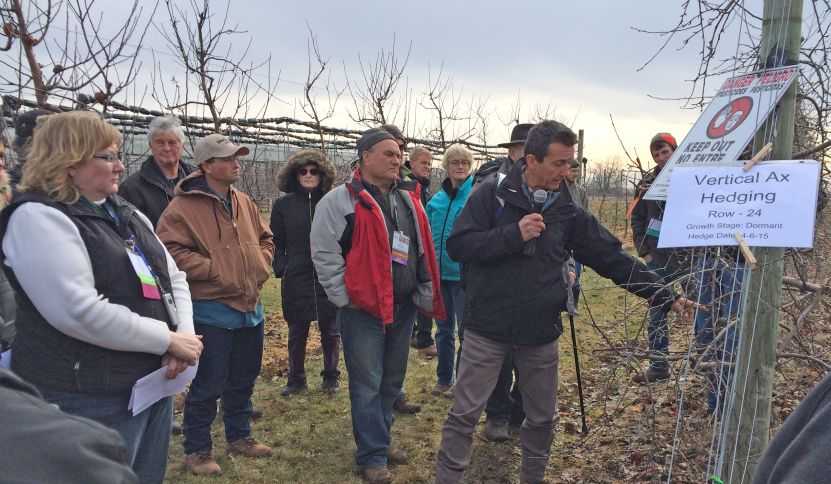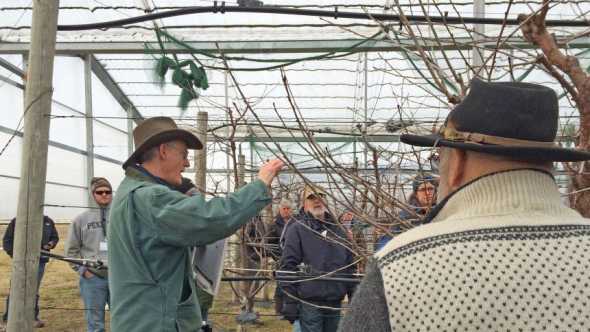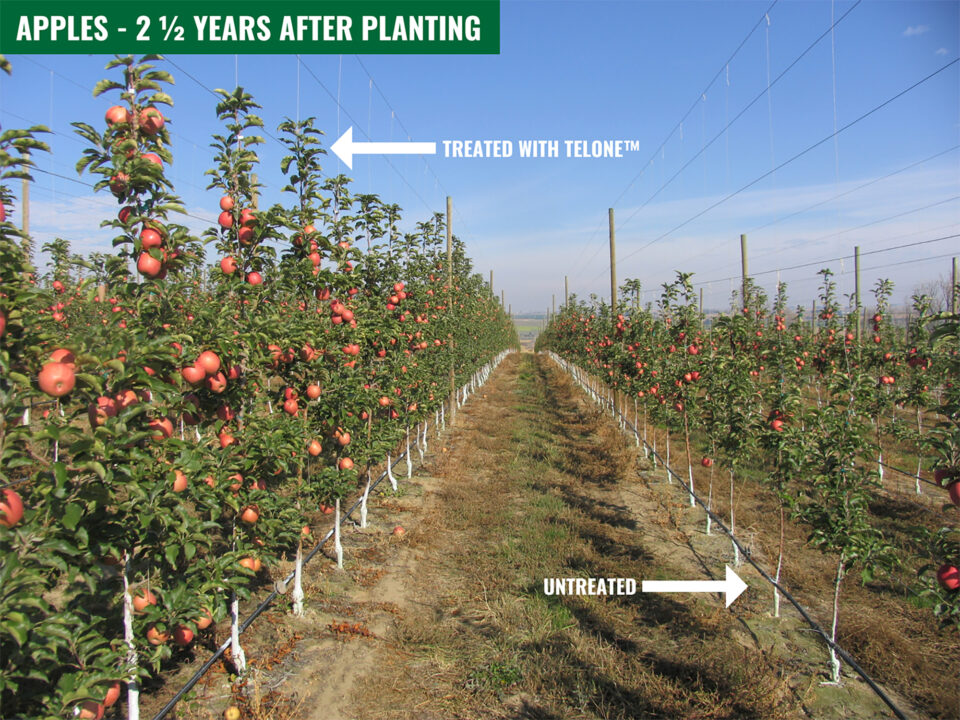Precision Fruit Growing, Business Management Top Agenda At IFTA Conference Kickoff

Alberto Dorigoni of Italy discusses window pruning and how to get more light into the tree canopy, a major component of a fruiting wall. Here, Dorigoni is looking at a mechanical hedging trial being conducted at the Michigan State University’s Clarksville Research Station. Find out more about Dorigoni’s findings on page 2.
Photo by Christina Herrick
Precision fruit growing means so much more than just training systems these days. Such was the theme of the preconference portion of the International Fruit Tree Association’s (IFTA) annual conference held in Grand Rapids, MI.
Matt Wells of Cornell University encouraged growers to understand the returns their blocks are making money and which ones aren’t, which should help fuel any orchard renewal decisions.
“If you have historical data, you know what variety/rootstock combinations work best from a yield standpoint,” he said.
Rod Farrow of Fish Creek Orchards in Waterport, NY, echoed Wells by telling growers they need to know where their business stands day-to-day in order to compete in the modern apple growing market. He also encourages wholesale growers to understand exactly what returns their apples are getting and what the returns of other growers are at the packhouse. “The difference between average and high returns can be two times or three times your bottom line,” Farrow said.
Ultimately, Farrow said growers need to become stronger businessmen in order to be competitive in the domestic market. “If you can’t compete, you stand to give all the equity back that you’ve made over the years,” he said.
Sam DiMaria of Bella Rosa Orchards in Kelowna, BC, commented that growers often have a failure to execute managing data and information learned from the business side of orcharding.
Brett Anderson of Anderson Brother Orchards in Sparta, MI, encouraged growers in attendance to get the next generation involved in managing the business and using computers to monitor the orchard’s data.
“Hire someone to free yourself so you can manage your business properly,” Farrow said. “It’s not a big expense to pay someone to run a tractor.”
Precision orchard techniques were revisited on the second day of the IFTA conference, where tourgoers got a look at Michigan State University’s (MSU) Clarksville Research Center. Greg Lang, professor of horticulture at MSU, commended the Michigan Tree Fruit Research Commission for its support of the Clarksville center and for investing in their future through research and Extension.

Greg Lang of Michigan State University talks about some cuts needed to be made on a tree in his NC-140 sweet cherry rootstock and training system trial.
Photo by Christina Herrick
Growers got a chance to look at some of the NC-140 sweet cherry rootstock and training system trials Lang is doing.
Lang says the block under high tunnels has focused on how to manage tree canopies to get good light and high quality fruit. Overall, still more research needs to be done to see how the rootstock and canopy structures continue to perform.
“I can tell you the best training system last year. I can tell you the best training system the last three years, but I can’t tell you what will be the best training system three years from now,” Lang says.
The group also got a look at the mechanical hedging trials that are being conducted on an old research block. Although the spacing isn’t necessarily ideal for hedging, the block was used to help growers understand new technology and equipment available.
“You guys like to buy equipment and we try to figure out how to use it,” Amy Irish-Brown, MSU Extension tree fruit educator.
Irish-Brown said some of the goals of the project are to focus on the inside of the tree canopy with renewal pruning and increasing sunlight. The research team measures return bloom and hopes to control biennial bearing with mechanical thinning.
Alberto Dorigoni from the Istituto Agrario Di San Michele All’Adige in Italy was also able to talk a little bit more about the fruiting wall, a topic of the the preconference workshop. At Clarksville, growers were able to get a better understanding of the fruiting wall concept at work.
“Manage with a narrow alleyway, keep the same production with less structure and reduce the length of secondary structures,” Dorigoni says are goals of a fruiting wall.
Dorigoni says a narrow canopy gets more homogeneous color.
Ultimately a fruiting wall should not cause a grower to grow a tree canopy to fit a specific piece of equipment.
“It’s good to adopt a tree to equipment, but as long as it doesn’t stray from the physiology of the tree,” Dorigoni says.
For more from the IFTA conference, check out Christina Herrick’s Twitter feed at @HerrickAFG.










